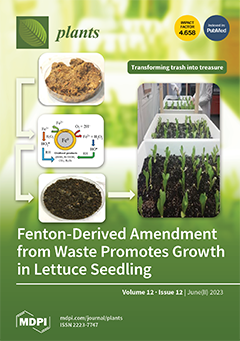Ensuring food security with severe shortages of freshwater and drastic changes in climatic conditions in arid countries requires the urgent development of feasible and user-friendly strategies. Relatively little is known regarding the impacts of the co-application (Co-A) of salicylic acid (SA), macronutrients (Mac),
[...] Read more.
Ensuring food security with severe shortages of freshwater and drastic changes in climatic conditions in arid countries requires the urgent development of feasible and user-friendly strategies. Relatively little is known regarding the impacts of the co-application (Co-A) of salicylic acid (SA), macronutrients (Mac), and micronutrients (Mic) through foliar (F) and soil (S) application strategies on field crops under arid and semiarid climatic conditions. A two-year field experiment was designed to compare the impacts of seven (Co-A) treatments of this strategy, including a control, F
SA + Mic, F
SA + Mac, S
SA + F
Mic, S
SA + F
SA + Mic, S
SA + Mic + F
SA, and S
SA + Mic + F
Mac + Mic on the agronomic performance, physiological attributes, and water productivity (WP) of wheat under normal (NI) and limited (LMI) irrigation conditions. The results reveal that the LMI treatment caused a significant reduction in various traits related to the growth (plant height, tiller and green leaf numbers, leaf area index, and shoot dry weight), physiology (relative water content and chlorophyll pigments), and yield components (spike length, grain weight and grain numbers per spike, thousand-grain weight, and harvest index) of wheat by 11.4–47.8%, 21.8–39.8%, and 16.4–42.3%, respectively, while WP increased by 13.3% compared to the NI treatment. The different Co-A treatments have shown a 0.2–23.7%, 3.6–26.7%, 2.3–21.6%, and 12.2–25.0% increase in various traits related to growth, physiology, yield, and WP, respectively, in comparison to the control treatment. The S
SA+ F
SA + Mic was determined as the best treatment that achieved the best results for all studied traits under both irrigation conditions, followed by F
SA + Mic and S
SA + Mic + F
SA under LMI in addition to F
SA + Mac under NI conditions. It can be concluded that the Co-A of essential plant nutrients along with SA accomplished a feasible, profitable, and easy-to-use strategy to attenuate the negative impacts of deficit irrigation stress, along with the further improvement in the growth and production of wheat under NI conditions.
Full article






